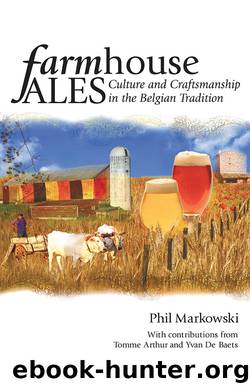Farmhouse Ales by Phil Markowski

Author:Phil Markowski [Markowski, Phil]
Language: eng
Format: epub
Tags: CKB007000 Cooking / Beverages / Beer
ISBN: 9780984075676
Publisher: Brewers Publications
Published: 2014-09-17T16:00:00+00:00
Brewing Techniques
Brewing was done by infusion since initially that was the most commonly used method in Belgium. Even after the widespread use of decoction, infusion remained the rule—farmhouse breweries generally used rudimentary equipment that wasn’t suitable for decoction.
Mash in was done at 40° C21. It is hard to get a precise idea of the brewing schedule of the era and its consequence on the production of fermentable sugars in the wort. Malt was very different from what we are familiar with today and had a lower yield. It appears that the goal was the production of the highest amount possible of fermentable sugars. The creation of a more dextrinous wort wouldn’t have posed a problem, however; the dextrins served as nutrients for the secondary wild yeasts and bacteria (see the “Fermentation” section). Brewers desiring a sour saison would have brewed more dextrinous worts to encourage the development of these wild fermentations that perfected the beer’s attenuation. Those who didn’t want such tartness would produce worts made entirely of malt with a high percentage of fermentable sugars and with much hopping22.
Worts varied greatly from one brewery to another but the final result was always a highly attenuated beer. Note that M. Jackson as well as R. Protz mention that saisons contain unfermentable sugars. They apparently are referring to the saison de Liège, a specific type of beer that has completely disappeared today and which did have unfermentable sugars (see previous). It is possible that certain current brewers who make a similar saison confirmed this to them, in order to justify their syrupy products. But it is clear that the “true” saisons don’t have many residual sugars, their attenuation being extraordinarily high.
The third runnings would often be used to make a bière de ménage or a bière de table (household or table beer), very low in alcohol (from 0.8 to 1.2% abv on average). The two were certainly mixed to make saison, since those farm breweries didn’t brew a wide range of beers. A wider range appeared when they ceased farming and became dedicated breweries after World War II.
The boil lasted for five to eight hours and sometimes up to fifteen hours “due to the generally accepted opinion that beer kept better the longer it was boiled.”23 This resulted in a deeper colored wort, intensified by the fact that the copper boiling kettles were generally heated by open fire. In addition, it was common to add lime to the boiling kettle to artificially deepen the color of the wort. This practice was denounced early in the brewing literature24, but it seems it was sometimes used until the early twentieth century.
Download
This site does not store any files on its server. We only index and link to content provided by other sites. Please contact the content providers to delete copyright contents if any and email us, we'll remove relevant links or contents immediately.
| Beer | Cocktails & Mixed Drinks |
| Coffee & Tea | Homebrewing, Distilling & Wine Making |
| Juices & Smoothies | Wine & Spirits |
Whiskies (Collins Gem) by dominic roskrow(42214)
101 Whiskies to Try Before You Die by Ian Buxton(42182)
Whiskies Galore by Ian Buxton(40332)
Craft Beer for the Homebrewer by Michael Agnew(17446)
Right Here, Right Now by Georgia Beers(3497)
Not a Diet Book by James Smith(2726)
Water by Ian Miller(2584)
The Coffee Dictionary by Maxwell Colonna-Dashwood(2531)
Kitchen confidential by Anthony Bourdain(2306)
Coffee for One by KJ Fallon(2007)
Smuggler's Cove: Exotic Cocktails, Rum, and the Cult of Tiki by Martin Cate & Rebecca Cate(1979)
Beer is proof God loves us by Charles W. Bamforth(1920)
Superfood Smoothie Bowls: Delicious, Satisfying, Protein-Packed Blends that Boost Energy and Burn Fat by Chace Daniella(1903)
Talking as Fast as I Can by Lauren Graham(1832)
Bourbon: A Savor the South Cookbook by Kathleen Purvis(1791)
A Short History of Drunkenness by Forsyth Mark(1720)
Eat With Intention by Cassandra Bodzak(1687)
Cocktails for the Holidays by Editors of Imbibe magazine(1626)
Colombia Travel Guide by Lonely Planet(1609)
